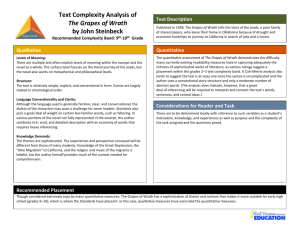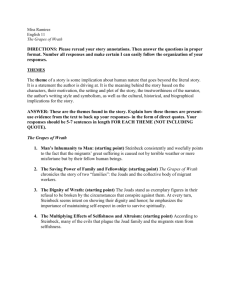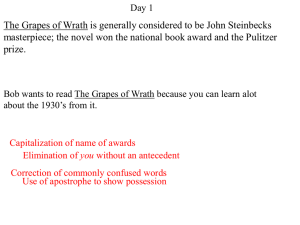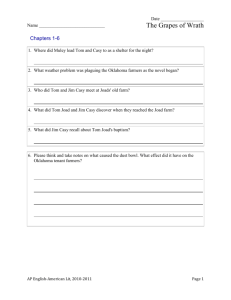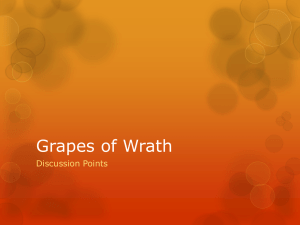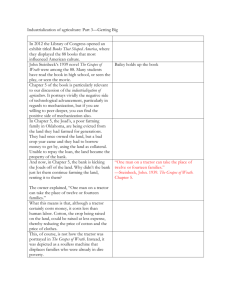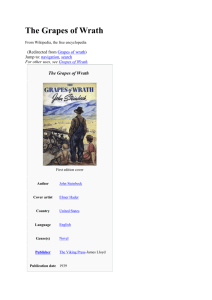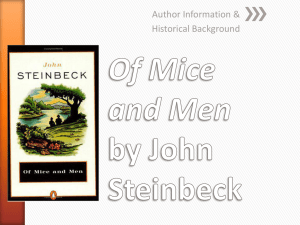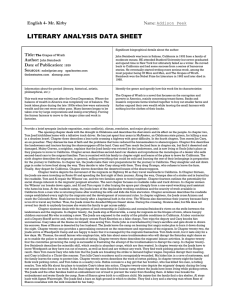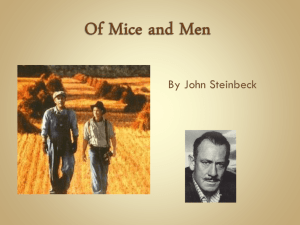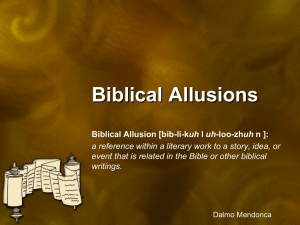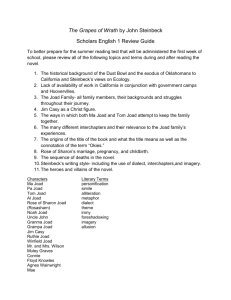The Grapes of Wrath ppt
advertisement
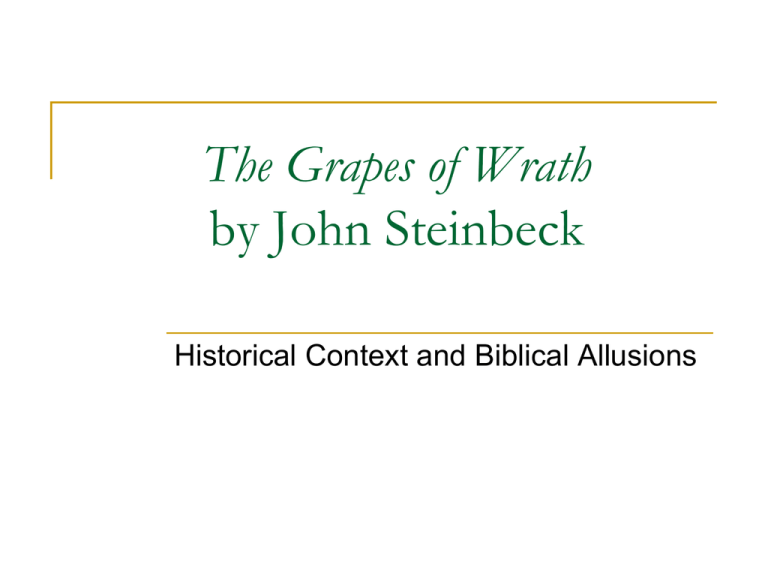
The Grapes of Wrath by John Steinbeck Historical Context and Biblical Allusions Critical Reception "The Grapes of Wrath may well be the most thoroughly discussed novel – in criticism, reviews, and college classrooms – of 20th century American literature." At the time of publication, Steinbeck's novel "was a phenomenon on the scale of a national event. It was publicly banned and burned by citizens, it was debated on national talk radio; but above all, it was read." According to The New York Times it was the best-selling book of 1939 and 430,000 copies had been printed by February 1940. In that month it won the National Book Award, favorite fiction book of 1939, voted by members of the American Booksellers Association. Soon it won the Pulitzer Prize for Fiction. Steinbeck wrote the novel in 100 days, but he had been researching it for years… So what inspired such a fervent and impassioned outpouring? What circumstance informed such an ardent appeal? What is this novel? Where did it come from? Let’s take a look… Historical Context – the 1930’s Trouble for farmers The Great Depression The Dust Bowl Migrant Camps Labor Unions The Grapes of Wrath was published in 1939 The novel is set in the time period during which Steinbeck was writing: the 1930s. This was one of the most economically, socially, and spiritually devastating eras in not only American history, but the history of the western world. Trouble for Farmers Troubles for American farmers had begun years before the story of the Joads in The Grapes of Wrath. Crop prices were high and favored American farmers when supplies of food were short and European markets were disabled. American farmers borrowed heavily from banks to invest in land and equipment. Trouble for Farmers Cont… After the war, however, prices for wheat, corn, and other crops plummeted as European farmers returned to their businesses, and American farmers were unable to repay their loans. Thus, in the 1920s, while much of the country was enjoying economic good times, farmers in the United States were in trouble. Trouble for Farmers Cont… Banks began to foreclose on loans, often evicting families from their homes. Families who rented acreage from landowners who had defaulted on loans would, like the Joads, be evicted from their homes. The situation, of course, became much worse after the stock market crash of 1929. The Great Depression In October, 1929, stock prices dropped precipitously, causing businesses and banks to fail internationally and wiping out the savings of many families. Over the next few years, unemployment rates soared up to twenty-five percent. Forty percent of the working population in America at the time were farmers. The Depression Cont… Low crop prices meant a lower income for farmers, and with a decreased salary came decreased spending on goods. People stopped buying unnecessary items such as radios and refrigerators. This had a ripple effect on the nation’s economy, manufacturing came to a standstill, people lost their jobs, businesses closed. The resulting pressure on banks to collect on loans caused them to evict many farmers. However, this wasn’t the only problem that plagued farm families. The Dust Bowl Six years of severe droughts (mostly natural, but also exacerbated by manmade conditions) hit the Midwest during the 1930s, causing crops to fail. This, compounded by poor farming practices such as overgrazing and failure to rotate crops, caused the land to wither and dry up. The Dust Bowl Cont… Great dust storms resulted that buried entire communities in sand. More than five million square miles of land from Texas to North Dakota and Arkansas to New Mexico were affected. The Midwest came to be called the Dust Bowl. Although no one escaped the economic pain this caused, small farm families similar to the Joads were the hardest hit. The Dust Bowl Cont… Of these states, Oklahoma was especially hard-pressed. Dispossessed farming families abandoned their land, piled their worldly goods on their trucks and took to Route 66 on an arduous exodus to California. This state seemed to promise ready jobs, decent wages and a decent living; a veritable land of milk and honey. These people were called “Okies,” although many of the migrant workers were from states other than Oklahoma. Watch: Surviving the Dustbowl Migrant Camps Upon taking office in 1933, President Franklin D. Roosevelt launched a comprehensive agenda of government programs to combat the Depression. Collectively called the New Deal, these programs included new federal agencies designed to create employment opportunities and to improve the lot of workers and the unemployed. Among the many such agencies, the one that most directly touched the Okies was the Farm Security Administration (FSA). Migrant Camps Cont… Operating under the authority of the Department of Agriculture, in 1936 the FSA began building camps in California in which the homeless migrants could live. Ten such camps were finished by the following year. Steinbeck visited several in his research for The Grapes of Wrath. Watch: Reflections on the American Novel Migrant Camps Cont… Steinbeck had the Joads stay at one of these camps—the Arvin Sanitary Camp, also called the Weedpatch Camp, in Kern County. The intention was that the orchard owners would follow this example and build larger, better shelters for their migrant workers. This never came about, however, and many families ended up staying at the uncomfortable – though infinitely better - federal camps for years. Labor Unions In an attempt to defend their right to earn living wages, migrant workers tried to organize labor unions. Naturally, this was strongly discouraged by the growers, who had the support of the police, who often used brute force to break up gatherings. In Kern County in 1938, for example, a mob led by a local sheriff burned down an Okie camp that had become a center for union activity. You will see this graphically depicted in the novel. John Steinbeck's "big book" begins to emerge. Steinbeck’s sensibilities favor the working man, the downtrodden, the dispossessed, and the marginalized. The experiences of these poor workers and their families were a consistent focus. Steinbeck wrote about many workers or laborers in California, the most notable, or his “Big Book” is The Grapes of Wrath Watch: His Novel’s Voice Before you begin… The Grapes of Wrath is clearly and unapologetically biased. It is considered a controversial novel in that it portrays Religious Leaders “obscene” Oklahomans negative simplistic portrayal of state inhabitants Californians cruel and predatory Americans in general “Communist” It draws attention to the plight of migrant workers Explicitly POLITICAL Champions collectivist action Anti-individualism, antimonopoly, anti-big business Like Modernist works, it reflects on man’s purpose in the world, but unlike most Modernist works, it draws a distinct conclusion about the way to live an authentic life. Watch: “A Chance to Work; A Chance to be Human” The Chronological Structure of the Novel Chronological 3 Logical Parts 1. 2. 3. “Oppression” : Drought and dust in Oklahoma “Exodus” : The journey west on Route 66 “The Promised Land”: California Intercalaray Chapters The Joad narrative is interspersed with chapters that are termed “intercalaray,” or something that is inserted, introduced, or interpolated On the surface, these chapters provide commentary or supply historical and social background that led to the present situation . The discerning reader, however, will note a highly thematic intention in these chapters as well as a variety of rhetorical techniques. Employing a variety of literary styles and techniques, Steinbeck is able to cross-reference details, interweave symbols, and provide outside commentary on narrative events in such a way that the two types of chapters blend together, unifying and enhancing the social and humanist themes of the novel. Juxtaposition in the Intercalary and Narrative Chapters Intercalary chapters Abuse of entrenched power, wealth, authority and tyranny Violations of migrant civil and human rights, ensuring their continued poverty and loss of dignity through threats reprisals and violence. The sectioning of America into financial, social, geographical caste system. Narrative (Joad) Chapters Unity of the family Challenges of survival Powerlessness, poverty, victimization, and fear of the nomadic American migrants Community in the struggle Desire for dignity, work, and land of their own Kept alive by innate resilience and resourcefulness Democratic benefits of the government sanitary camps. Hope against all odds The Novel’s Style Vivid imagery and close attention to detail "The dust-filled air muffled sound more completely than fog does" Figures of speech such as simile, metaphor, and personification “The full green hills are round and soft as breasts” Dialect "a walkin' chunk a mean-mad" Realism Dialect, Steinbeck’s research methods Setting, gritty and detailed Genre “Like other products of rough hewn American genius. . . The Grapes of Wrath has a homegrown quality: part naturalistic epic part jeremiad part captivity narrative part road novel part transcendental gospel” jeremiad: a prolonged lament or complaint, as in the Hebrew prophet Jeremiah American Transcendentalism (Emerson): core belief an ideal spiritual state that “transcends” the physical and empirical and is only realized through the individual's intuition, rather than through the doctrines of established religions. Main Characters Tom Joad (main character) Ma and Pa Joad Granpa and Granma Rosasharn (Rose of Sharon) and Connie The other Joads: Noah, Ruthie, Winfield Reverend Jim Casy – spiritual lynchpin Ivy and Sairy Wilson Major Themes Forces of the Times: "An' Almighty God never raises no wages" (265) Family First: "Use' ta be the fambly was fust. It aint so now" (470, 148) Power of the Group The People's Justice: "They's change a-comin'. They's a res'less feelin'." (365, 184) Survival "Ever'thing we do ..is aimed right at goin' on."(448) Identity: "He was that place an' he knowed it." (156, 95) Faith: "How can such courage be and faith in their own species? ... Faith is refired forever" (130) Choices and Regret: "The one-eyed man . . cried in his bed" (193) Trusting one's own instinct: "I got a feeling I got to see them" (58, 149) Redemption – Where there is life…. (last page – you will weep with Ms. Gerber – yeah, again) Steinbeck on the Writer’s Imperative “The writer is charged with exposing our many grievous faults and failures for the purpose of improvement. . . Furthermore, the writer is delegated to declare and celebrate Man's proven capacity for greatness of heart and spirit - for gallantry in defeat, and for courage, compassion and love." --Steinbeck in his Nobel Prize acceptance speech (1962, Literature) Biblical Allusions Central to your understanding and appreciation of this amazing novel (no apologies – I love it) is your awareness of the many biblical allusions at work. Think about why Steinbeck chose the Bible as his reference. You’ll want to keep an eye out for Characters Situations Quotes Rose of Sharon Hibiscus syriacus: Flower mentioned frequently in the Bible In the Song of Songs, this flower is compared to a humble, young woman (ordinariness) Ironically, an ordinary flower with extraordinary qualities, as seen by her remarkable act of generosity at the end of the novel (gives hope to man) Pietá: picture or sculpture of Virgin Mary holding the dead body of Christ on her lap or in her arms Ruthie From the Book of Ruth -She was a foreigner, but was very patient and ended up marrying royalty because of her character. How does this connect with the novel? (HINT: It has to do with the Land of Milk & Honey…think of Sally from Wright’s “The Man Who Saw the Flood”) The Joads/Book of Job 18th book from Old Testament Satan visits God and God permits Satan to test Job. Satan destroys all of Job’s material possessions and family to test Job’s faith in God Job’s faith remains strong despite his misfortunes How is Job’s experience analogous to the Joads? Noah and the Flood Joad car (packed w/ possessions) = Noah’s Ark (crammed w/ animals) Flood = Dust Bowl (Man vs. Nature) Struggle for survival Noah Joad follows the river on his own and can’t bear to stay with his family (Ch. 18) Noah spent 40 years afloat on the Ark separated from the world Other Biblical Allusions California = Canaan (Promised Land of the Israelites; “Land of Milk & Honey”) Moses and concepts of survival and salvation = Let my people go – Go down and tell them… Joads, like the Hebrews, go through many trials to reach California (the Promised Land) Insect references/description of changing land similar to the Exodus plagues (locusts, disease of livestock, etc.) Book of Exodus: Migrants = Hebrews Displaced; in search of the Promised Land Other Biblical Allusions Connie Rivers = Judas Iscariot Connie abandons family at critical moment in Ch. 20 -- told Rose just before he left he would have done better “if he stayed home an’ studied up tractors” -- allusion to farmer-turned-tractor driver of Ch. 5 (betrayal) Judas betrays Jesus Christ to Jewish authorities for 30 pieces of silver Jim Casy JIM CASY: voice of modern faith not a hypocrite even though he is a sinner arrested without premise, much like Christ in the Garden of Gethsemane Takes blame for Tom Joad, like Christ for humanity. When Casy leaves the narrative after the Hooverville scuffle, he is wondering how he can help “the people” When Casy returns in Ch. 26, he is a determined organizer of migrant workers; nomadic and clear-minded (like Christ!) Casy and His Works Jim Casy and Jesus Christ both changed the authority of the common man’s ability to rise above oppression Casy struggles with his life’s purpose; Jesus struggles with his (Matthew 26:36-46, Mark 14: 32-42, Luke 22: 39-46.) Jim arrested in Hooverville camp; Jesus arrested in Garden (Matt 26: 47-56, Mark 14: 43-52, Luke 22 : 47-50) Jim teaches Tom; Jesus teaches his disciples (Matthew 6:5-15, Luke 11: 1-13) Casy’s last words in novel: “You fellas don’ know what you’re doin’”; Christ’s final words: “Father, forgive them; for they know not what they do. Casy’s Doctrine Casy: “…maybe it’s all men an’ all women we love; maybe that’s the Holy Sperit -- the human sperit -- the whole shebang. Maybe all men got one big soul ever’body’s a part of.” (Ch. 4) Casy believes in the unity of mankind -- to offend others is to offend yourself Christ: “Love thy neighbor as thyself” Tom Joad as an Apostle of Jim Casy’s Returns home from McAlester Prison like Prodigal son (Luke 15:11-32) Even though he is a murderer, he evolves to be a devout follower and an advocate for JC Tom Joad = early Christians, carrying on Christ’s message after he is gone Tom takes up Casey’s cause after he is gone -reversal of roles – first Tom acts and Casey talks At end, Tom talks and Casey acts Significance of the Title The story goes that Steinbeck struggled for a title for his “Big Book”. "The Grapes of Wrath“ was suggested by his wife Carol Steinbeck. The title is a reference to lyrics from "The Battle Hymn of the Republic” Mine eyes have seen the glory of the coming of the Lord: He is trampling out the vintage where the grapes of wrath are stored; He hath loosed the fateful lightning of His terrible swift sword: His truth is marching on. (Chorus) Glory, glory, hallelujah! Glory, glory, hallelujah! Glory, glory, hallelujah! His truth is marching on The song was written by abolitionist Julia Ward Howe in 1861, the night after she visited a Union army camp The hymn became a kind of anthem for the abolitionist cause and for the Union soldiers during the Civil War in America. The hymn summons God to bring justice to those who have wrecked havoc over the land and over its people. In other words, the injustice of slavery, (the darkest chapter in American history) is so great that God will bring answer it with an act of vengeance. Origins of the Reference Julia Ward Howe took her reference from the Bible and the Book of Revelations: St. John’s divine vision of the future of mankind; last book in New Testament “So the angel swung his sickle on the earth and gathered the vintage of the earth and threw it into the great winepress of the Wrath of God. And the winepress was trodden through the city, and blood came out of the winepress, even unto the horse bridles, by the space of a thousand and six hundred furlongs” (Revelations 14: 18-19) Is this an apocalyptic warning? The squishing of "the grapes of wrath“, the widespread and graphic depiction of the spilling of blood, are violent and emotional images and closely associated with the widespread oppression of a people. Dust Bowl oppression the wrath of the dispossessed and displaced masses (like God’s divine justice) Workers’ justice and “deliverance from evil” achieved through cooperation (i.e., family, organized labor, compassion) Where there is anger – there is hope. The Title, continued The phrase also appears at the end of chapter 25 in The Grapes of Wrath which describes the purposeful destruction of food to keep the price high: ...and in the eyes of the hungry there is a growing wrath. In the souls of the people the grapes of wrath are filling and growing heavy, growing heavy for the vintage. The image invoked by the title serves as a crucial symbol in the development of both the plot and the novel's greater thematic concerns: from the terrible winepress of Dust Bowl oppression will come terrible wrath but also the deliverance of workers through their cooperation. Biblical Parallels “On one level it is the story of the family’s struggle for survival in the Promised Land. . . . (Abraham, Isaac, and Sarah) On another level it is the story of a people’s struggle, the migrants’. (Israelites--Exodus from slavery in Egypt) On a third level it is the story of a nation, America. (Biblical Nation of Israel) On still another level, through the allusions to Christ and those to the Israelites and Exodus, it becomes the story of mankind’s quest for profound comprehension of his commitment to his fellow man and to the earth he inhabits.” Critical Motifs to Note as You Read Motifs are reoccurring ideas, symbols, statements. You will not note several in this novel. Note where these motifs occur in the narrative. Metamorphosis Expectation vs. Reality The American Dream The loss of human dignity threatens existence Survival rests in group action The need for brotherly love Amassed bitterness will lead to negative action There is merit in the agrarian way of life Pragmatism Prejudice Continuation of the life cycle The Loss American of Dignity Dream – that Expectation vs. Reality idea that the every man, or anyone, can Metamorphosis What happens to a people k succeed this land by perseverance and Note theindisparity between the hope •Landscapes individual What does efforts, the myth appears saycomes about oddly awith perverse, person and the outcome that reproachful who has notand prospered? unredeemable. •Colors The workreflection What Howpromise are doesSteinbeck’s the of notion of the American on this •Values mythology Dream serve against to a backdrop marginalize of the The promise offurther basic humanity widespread dispossed?want and poverty? •Lifestyles The promise of family What Whatdoes would the Steinbeck myth saysay about should a person become •Roles who of this has dream, not prospered? theAmerican teat on which all The promise of institutions Americans suckle?in the •Note especially How does the of the American The promise notion of prosperity metamorphosis of themarginalize Joads the Dream serve to further dispossed? The promise their of the land roles, themselves, shifting values, andSteinbeck their perspective What would saysense should of become The promise of a basic right especially at the end of the novel. of this dream, the teat on which all Americans suckle? The Message – The Pot of Gold at the End of Your Literary Rainbow (Corny) John Steinbeck's 1939 novel is the wrenching story of the "Okies," the Oklahoma farmers dispossessed from their land and forced to become migrant farmers in California during the Great Depression. First regarded as a protest novel and only later as a work of art, THE GRAPES OF WRATH describes the Joad family's exploitation by a ruthless system of agricultural economics. Steinbeck’s style, his point of view, his rhetorical devices clearly place him behind the line of the Joads, who are clearly heirs to our empathies. So what’s the point? What is the moral, the message, the universal truth of existence Steinbeck would have us understand?
